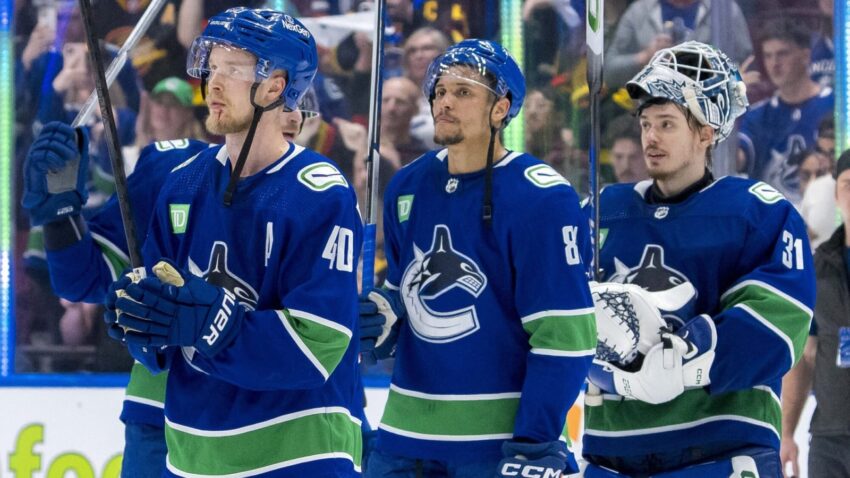
There’s been a lot of talk about the value of various draft picks in Vancouver of late and with good reason. Former 10th overall pick Vasily Podkolzin was just dealt to the Edmonton Oilers for a fourth-round selection that will fall somewhere in the 100s, a trade that might be perfectly reasonable and justifiable but still feels like a loss regardless.
After such a trade, it’s only natural to start wondering things like, “What’s a draft pick really worth?”
Last week, we attempted to estimate the general value of that fourth-round pick itself. Today, we’re taking a bit of a backwards approach to the inquiry by breaking down the current composition of the Canucks’ roster by where each player was drafted.
The idea goes that, in seeing how the Canucks are currently constructed, there’s something to be learned about the average value of each round of the draft and which picks are actually most likely to wind up becoming contributing members of an NHL team one day.
For the purposes of this thought experiment, we’re going to expand the roster a little bit to include all those players with a decent shot of making it out of Training Camp 2024, and we’re not going to worry too much about the arrangement of the lines – they’re just placeholders at this point.
The Forward Corps (Round/Pick)
| Danton Heinen (Undrafted) | JT Miller (1/15) | Brock Boeser (1/23) |
| Jake DeBrusk (1/14) | Elias Pettersson (1/5) | Nils Höglander (2/40) |
| Dakota Joshua (5/128) | Pius Suter (Undrafted) | Conor Garland (5/123) |
| Kiefer Sherwood (Undrafted) | Teddy Blueger (2/52) | Daniel Sprong (2/46) |
| Phil Di Giuseppe (2/38) | Nils Åman (6/167) | Linus Karlsson (3/87) |
There are folks out there who believe the only draft picks really worth anything are first-rounders and maybe high seconds. There’s little on the current Canucks forward corps to dissuade such opinions.
Four of the current Vancouver forwards were drafted in the first round, and those four are almost inarguably the Canucks’ best in Miller, Pettersson, Boeser, and DeBrusk. Another four forwards, Höglander, Blueger, Sprong, and Di Giuseppe, were drafted in the second round.
That means if Höglander and Sprong lock down top-six spots for themselves coming out of camp, which is a distinct possibility, the Canucks will have a top-six comprised entirely of players drafted in the top two rounds – not to mention a full half of their forward corps.
Beyond that, it gets interesting. The Canucks have nearly as many undrafted players on the forward roster (Heinen, Suter, Sherwood) as they do players drafted after the second round (Garland, Karlsson, Joshua, Åman).
For those folks who discount the value of mid-to-late-round draft picks, there’s some good evidence to point at here. The Canucks, at least, seem to have got as much NHL talent out of the pool of players who were never drafted than they have out of players drafted from picks after 60th overall.
The Blueline
| Quinn Hughes (1/7) | Filip Hronek (2/53) |
| Carson Soucy (5/137) | Tyler Myers (1/12) |
| Derek Forbort (1/15) | Vincent Desharnais (7/183) |
| Mark Friedman (3/86) | Noah Juulsen (1/26) |
| Tucker Poolman (5/127) |
In terms of draft picks, the Canucks’ blueline is also a little top-heavy. Maybe even more so.
Four of the players slated to make up the Canucks’ defence corps in 2024/25 were drafted in the first round, with three of them (Hughes, Myers, and Forbort) being taken in the first half of the first round.
Hronek was a late second-round pick himself, and Friedman went late in the third. And then the rest of the crew is made up of what we might call outright ‘late picks,’ with two in the fifth round (Poolman and Soucy) and one in the seventh (Desharnais).
At the very least, this lends a little more credence back to the value of later-round selections, with Soucy being picked in the fifth round and now slotted into the top four.
That there are no undrafted players in this section of the roster tells us what we probably already knew inherently: it is a tougher uphill climb for an undrafted defender to crack an NHL roster than it is for an undrafted forward.
The Goaltending
| Thatcher Demko (2/36) |
| Arturs Silovs (6/156) |
| Jiri Patera (6/161) |
It’s often been said that goalies are nigh-unpredictable, and it’s hard to argue against.
The Canucks’ would-be starter (as in, he would be if he were healthy) Demko was technically a second-round pick, but he was just two picks off of being a first-rounder by today’s 32-team standard. He’s still what they might call a premium-value draft choice.
However, the following two goalies on the depth chart were each picked in the sixth round.
Some folks argue that it is always a wise move to grab a netminder or two late in each draft because there really seems to be little rhyme or reason to how things go post-draft. The presence of Silovs and Patera here would seem to be in favour of that argument.
